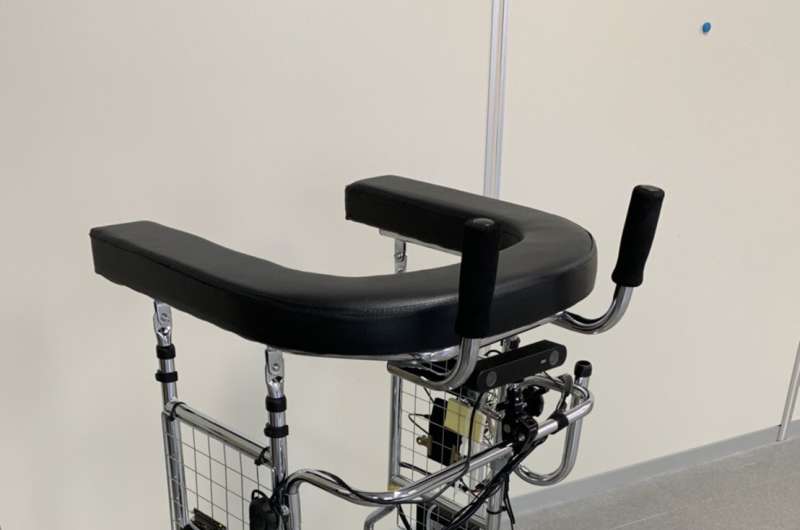An autonomous forearm-supported walker to assist patients in nursing facilities
Over the past few decades, roboticists have developed systems for a variety of real-world settings, including healthcare facilities. Among their many possible uses in healthcare, robots could help to assist patients in nursing homes or hospitals; for instance, administering medication, food or helping patients to walk.
Researchers at Hokkaido University in Japan have recently developed an innovative autonomous system that can serve as a walking aid for patients in nursing facilities or hospitals. This robotic medical walker, presented in a paper published in SpringerLink’s Artificial Life and Robotics journal, does not require any intervention from nurses and caregivers, as it can autonomously locate patients and approach them when they wish to go for a walk or move to a different place within their healthcare facility.
“If a patient is able to walk using a walker, doctors typically recommend walkers over wheelchairs as a tool to perform moderate exercise in nursing facilities,” Yuto Mori, one of the researchers who carried out the study, told TechXplore. “To use a walker, however, caregivers must first carry it to the patient, which can be a burden on caregivers and can reduce the patients’ sense of autonomy. The main purpose of our research was to solve this problem by creating a robotic walking system that could be used by those in nursing facilities or other healthcare settings without any intervention from caregivers.”
Similarly to conventional walkers, the autonomous system developed by Mori and his colleagues can support a user’s weight and assist him/her in walking around a nursing facility. In addition to supporting patients during their walks, however, the system can also autonomously drive toward users when they wish to take a walk.
“The system we developed has two main functions: a walking support function for walker users and an autonomous driving function for caregivers,” Mori explained. “The walking support implies that the brushless DC (BLDC) motor [ensures] the wheels of the walker are rotated in the travel direction to reduce the user’s walking load. The autonomous driving function, on the other hand, uses the ROS navigation stack to self-drive the system to a user’s location.”
The researchers evaluated their autonomous walker in a series of experiments, testing both its ability to support people as they are walking and its efficiency in autonomously reaching users when they wish to take a walk. Their findings were highly promising, as they found that it could achieve both these functionalities, even when it was fabricated using low-cost components.

In the future, the system could be implemented in nursing facilities worldwide to assist patients and simplify the work of nurses or caregivers. In contrast with other robotic systems for healthcare applications, the autonomous walker is also very cost-effective and is thus easier to implement on a large-scale.
“In our next studies, we plan to develop an algorithm that can appropriately sense the user’s condition and determine the appropriate amount of assistance required by each user to enhance the walking support function,” Mori said. “In addition, we plan to develop an emergency stop function and an appropriate obstacle avoidance algorithm to ensure the system’s safety.”
Yuto Mori et al, Development of an autonomous forearm-supported walker for nursing facilities. Artificial Life and Robotics(2021). DOI: 10.1007/s10015-021-00698-8
© 2021 Science X Network
Citation:
An autonomous forearm-supported walker to assist patients in nursing facilities (2021, October 1)
retrieved 1 October 2021
from https://techxplore.com/news/2021-10-autonomous-forearm-supported-walker-patients-nursing.html
This document is subject to copyright. Apart from any fair dealing for the purpose of private study or research, no
part may be reproduced without the written permission. The content is provided for information purposes only.
For all the latest Technology News Click Here
For the latest news and updates, follow us on Google News.
